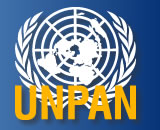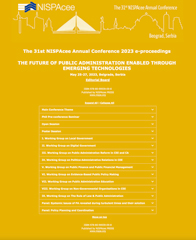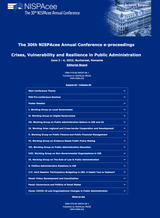SocialInnovations and the Role of Local Policy: a summary of the findings of the WILCO project (2010-2014)
The WILCO project examined social innovation in European cities and how it is related to urban governance. Although the type of social problems is broadly similar across cities, local responses differ greatly. Four different types of urban innovation regimes were identified, as were the conditions most crucial to the survival and diffusion of innovations.
The findings are accessible in the form of three mini-documentaries which explain our findings in 3 x 15 minutes. The videos and other outputs are available through the website www.wilcoproject.eu.
During the recent years of economic crisis, European cities have seen a huge growth in distress and inequality. At the urban level, these massive challenges become visible and tangible, which, in many ways, makes cities a microcosm of society. It means that local welfare systems are at the forefront of the struggle to address this challenge – and they are nowhere near close to winning. Whilst the statistics show some positive signs, the overall picture still shows sharp and sometimes increasing inequalities, a loss of social cohesion and failing policies of integration. When we focus on specific groups in society (e.g. migrants) the situation is even more appalling. It is evident that new ideas and approaches to tackle these very terrible problems are required.
Such ‘social innovation’ has become a buzzword in policy circles and features prominently on the agenda of the European Union. Yet there is still little solid evidence of how social innovation works. We hear mostly about the success stories, but what is the overall picture? And what is the role of local governments and policies?
Fresh evidence now gives us more insight into the dynamics of this process. The EU-funded WILCO project has just published the findings on extensive research in European cities, which included four eastern European cities and was supported by NISPAcee.
Background of the project
The project ‘Welfare Innovations at the Local Level in Favour of Cohesion” (WILCO) was funded by the European Union with 2.4 million Euro to identify innovative practices in European cities and the factors that make them emerge and spread, including the role of urban governance and welfare policies. The project brought together universities from ten countries (Croatia, France, Germany, Italy, The Netherlands, Poland, Spain, Sweden, Switzerland, UK), as well as the research networks, EMES and NISPACEE, and was coordinated by Radboud University Nijmegen.
We selected twenty European cities (two per country) on which we focused our remaining research. The chosen cities were: Münster and Berlin Friedrichshain – Kreuzberg (DE); Zagreb and Varaždin (HR); Amsterdam and Nijmegen (NL); Barcelona and Pamplona (ES); Milan and Brescia (IT); Stockholm and Malmø (SE); Birmingham and Medway area (UK); Warsaw and Plock (PL); Lille and Nantes (FR); Bern and Genève (CH). These were then examined through a combination of qualitative and quantitative methods, described in more detail in our reports.
Innovation regimes: how local policies interact with social innovation
An important goal of our project was to identify how the governance of cities related to innovation. The differences turned out to be quite substantial. We identified four kinds of regimes, characterised by different relations between social and economic policies at the city level:
·The governance of innovation is characterised by the continuous search of synergies between economic and social policies. The political consensus is fragile, but stabilises ambivalences in the city’s driving coalitions around the idea of the innovative (or creative) city. The coalition’s major orientation is to foster urbanity as a project and as a way of life, bohemian and innovative, open to differences and responsive to marginality. Through urbanity, which is the guiding hypothesis, economic dynamics would be improved. From the organisational point of view, this governance style privileges welfare mix solutions. Values that all actors share are the idea of urbanity, pragmatism and efficiency; ideologies are secondary in the definition of policy priorities. Examples of this governance style were Bern, Münster, Barcelona and Varaždin. Varaždin’s orientation was developed following indications from the EU.
·The governance of growth gives priority to economic policies. The orientation is anti-urban and politics are strongly influenced by economic interest groups. This growth machine orientation privatises social problems as individual faults. Pamplona and Birmingham were examples of the predominance of this kind of governance.
·The governance of social challenges gives priority to social policy orientations in the production of services. Economic dynamics are handled parallel to social policies and are not related to, or in conflict with them. This results in more traditional social welfare policies in which the local state plays a primordial role in the production and distribution of services. Political parties and party politics define this orientation and the dominant, more paternalistic choices in the field of social policy. Shared values are solidarity and the social responsibility of the state. Cities such as Malmø, Stockholm, Geneva, Lille, Nantes, Nijmegen, Brescia, Zagreb, Warsaw and Plock were examples of this kind of governance. With regard to Zagreb, Warsaw and Plock, we again find the EU as the dominant partner in the definition of the governance style.
·Finally, we identified a conflicting governance of social and economic challenges. In this case, a combination of a weak local government and strong economic and social interest groups creates concurrence between economic and social investments. The value orientation in the field of social policies is conflicting with an opposition between a social and an economic lobby. Each social policy creates a debate between individualism (and individual responsibility) vs. solidarity and a collective responsibility. Berlin and Milan were examples of such a conflicting type of governance.
Encouraging social innovation
There is a tendency in publicity on social innovation to discuss successful cases and those that are scaled up to a system-wide level. Based on our evidence, it must be concluded that the reality of local social innovations is different. The majority remain local and last only a limited number of years. The emphasis on success stories and scaling-up is important, but it is equally important to realise that the majority of local innovations do not fit such a pattern of growth and that one should not disregard the cumulative effect of the many small, temporary initiatives that are of high value within their local context. Public policy should therefore not only focus on the selective group of innovations with a high growth potential, but also on the capacity of cities to continue generating many new initiatives of a highly local nature.
Of the innovations we studied, the majority were either discontinued after a few years or faced an uncertain future in the short term. Cutbacks in public sector funding no doubt play a part in this, but the underlying structural dynamics, such as project-based funding, dependence on charismatic initiators and shifting political fashions, suggest that the underlying conditions are of a structural nature.
The most sustainable innovations were those that were either fully integrated into the local welfare administration or even initiated by the local authorities. Generally, local authorities tended to favour innovations that were complementary to their growth strategy, aimed at making the city more dynamic and attractive. This means that there is not necessarily a smooth fit between social innovation and economic growth agendas.
Another factor that affected innovations’ chance of survival was whether they involved a wide coalition of parties. Such parties could include the third sector, local governments, businesses and groups of citizens. A broad alliance made it easier to sustain innovation, even when one of the parties (such as the local authorities) withdrew its support. Highly vulnerable were those innovations which were primarily dependent on European funds.
Finally, what also mattered, to a large extent, was the governance style of local authorities. Innovations could more easily gain recognition and sustainability where there was an open governance style, that is, where authorities proved open to contributions to local welfare by different parties. To some extent, such openness appeared related to institutional factors, such as the level of decentralisation within the state structure and historical traditions of working with the third sector; but it also depended on the nature of local politics, the prevailing discourse and availability of people who could act as ‘boundary spanners’, connecting both institutional and life worlds.
The diffusion of innovations
Another way for social innovations to maintain a longer life is for them to be diffused to other cities and countries. However, local governments sometimes focus too much on finding ‘magic solutions’ and too little on the groundwork that needs to be done locally in order to make solutions effective.
Most of the publications on the diffusion of innovations are based on market contexts and commercial products, but social innovations are different. The nature of products made for the commercial market is that they are not made primarily for the local market, but deliberately designed to spread widely to other places. Social innovations, by contrast, are usually initiated to solve a local problem. Wider diffusion is only of secondary importance to the innovators, if not irrelevant. The image of the highly visible entrepreneur giving TedX talks is, in this case, unrepresentative. Therefore it is especially important for this type of innovation to have intermediaries who know the situation on the ground and assess what it takes for innovations to take root elsewhere.
Unlike many products, which can shift places easily, social innovations have to be ‘translated’ to be effective elsewhere. It is rare to have a straight transfer of an idea from one city to another, although we did find some examples of this (for initiatives that were typically low-resource, low-skill). Approaches or projects will, in some way, need to be adapted to the context into which they are adopted. For instance, what is originally a project to keep young people socially active may elsewhere be justified with the discourse of unemployment or crime prevention. The shape of a collaborative arrangement may have to be altered, for example, because responsibilities for a certain policy area are distributed differently over governments at different levels, or because services are provided privately in one country and publicly in the other. The innovation will need to be re-shaped. The adaptation may concern the structure of an innovation, e.g. its formal organisational shape, but also the regulation that supports it, the instruments through which it is implemented, or the discourse with which it is described and justified. Innovations are therefore usually hybrids of different ideas and inspirations.
Given that such a process of reconstruction and translation must take place, it requires new ways of collaboration, for example, between governments and citizens, and new ways of thinking. Our material shows that, in local welfare, this process does not start when an innovation is introduced, but usually well before that. Rather, it is the other way round: an innovation is adopted when minds are ripe. A good idea is not convincing in itself – it comes when people are open to it. What this means is that adopting an innovation from elsewhere is, from the perspective of the adopting parties, not fundamentally different from inventing one. After all, it requires similar breakthroughs in institutional routines, whether of content, collaboration, or other aspects of working. This is highly relevant to public administration reform, because it means that simply finding the right kinds of solutions to policy problems is in itself not enough. It requires a different approach to governance to make the solutions work effectively.
Further resources
Let me welcome everyone to look at our findings in more detail on our website. In particular, I recommend the following free resources:
-Three mini-documentaries explain our findings in 3 x 15 minutes: http://www.wilcoproject.eu/videos/.
-City packages show, for twenty European cities, the interaction between social problems, local welfare polices and politics, and emerging social innovations. The cities covered include Plock, Varaždin, Warsaw and Zagreb. See http://www.wilcoproject.eu/reports/city-package/.
-The innovations are systematically described and comparatively analysed in the e-book Social Innovations for Social Cohesion: Transnational Patterns and Approaches from 20 European cities, available for download at http://www.wilcoproject.eu/ereader-wilco/.




 Price:
Price: 








